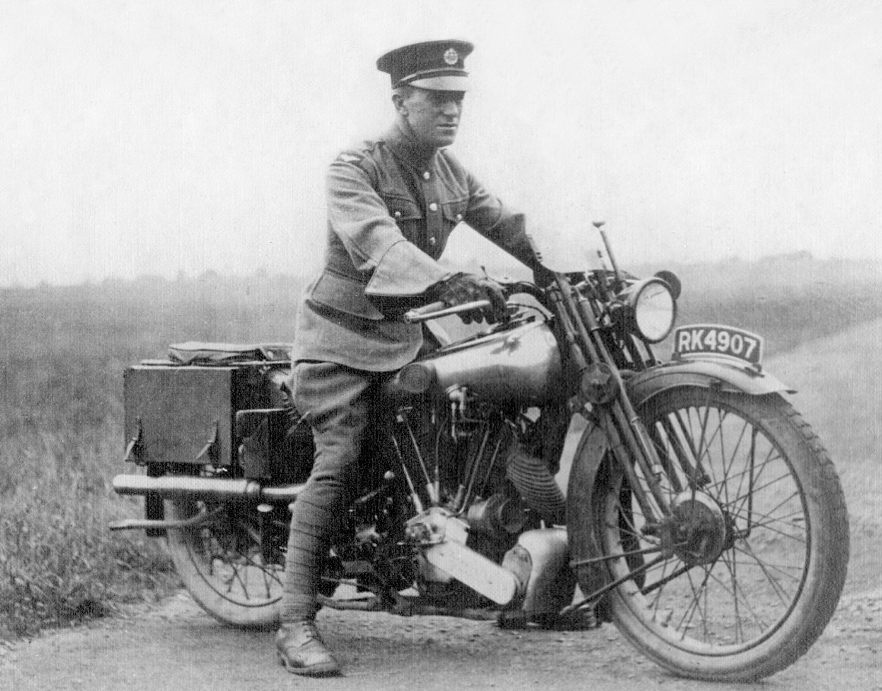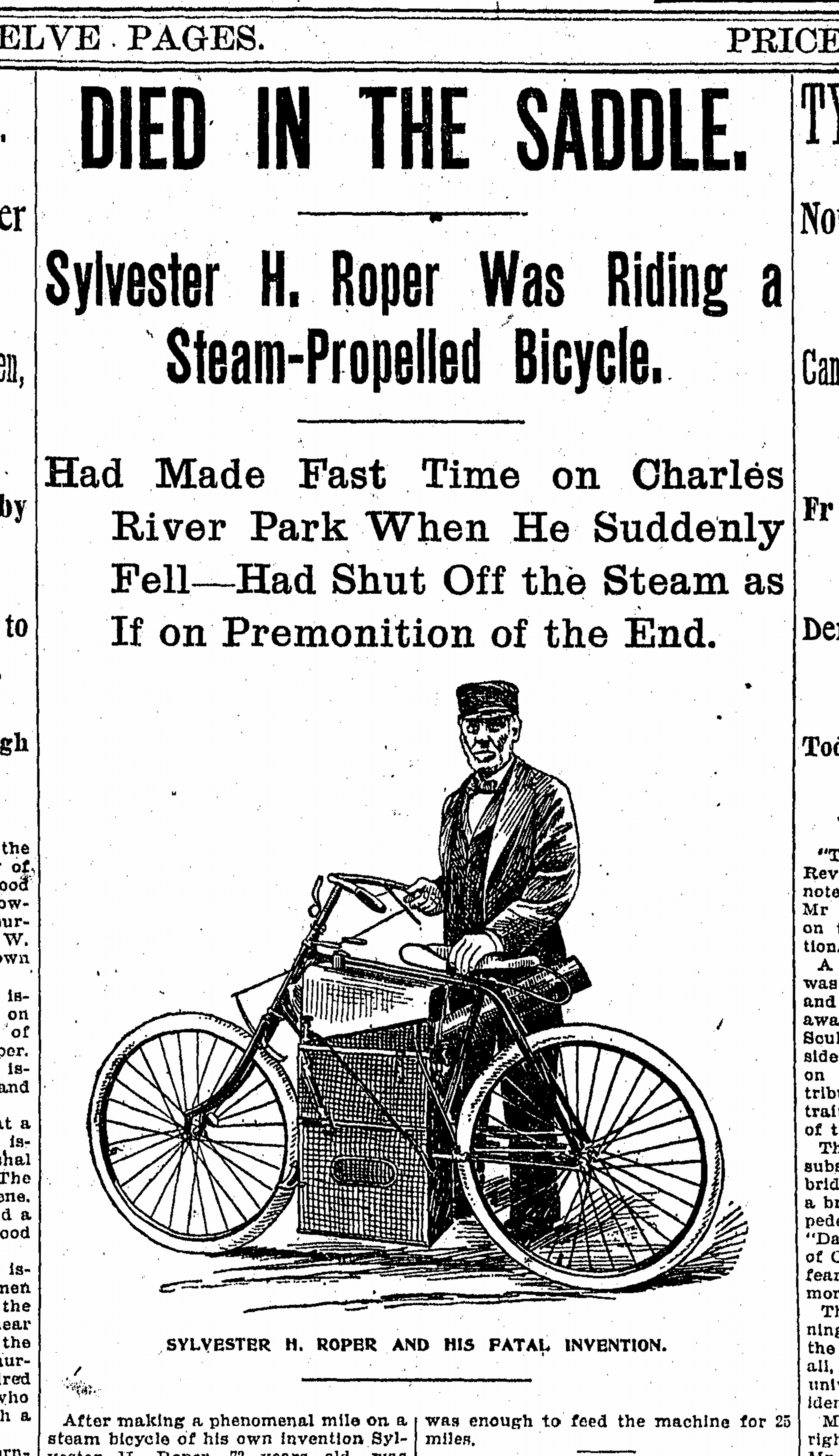I must begin by apologising for what is turning into one of the quietest months of blogging I've experienced in a long time. It's been partly due to work and other calls upon my time but mainly because there has been little vintage news to blog about! Perhaps everyone is
bracing themselves for looking forward to a certain event starting at the end of the month... As it is I've almost forgotten how to do this blogging lark, so I'm sorry if this post isn't up to snuff(!).
I've had the idea for this post buzzing around my head for some time now, having come across several motorbikes I really like the look of (and think you would too) - both real and imaginary. Time to get them off my mind and into this blog!
 |
| Dad's last classic 'bike, a 1960 AJS. Sold in 1997, sadly. |

Motorcycles aren't really my area of expertise (I prefer my vehicles to have at least
3 wheels under them!); they come more within the purview of my father, who's been riding the things since the 1960s. Being mechanical objects I have a passing interest in them but with these modern 'bikes I couldn't tell a Honda from a Hayabusa. I much prefer motorbikes from the first half of the 20th century (naturally!), particularly the classic-styled British makes of which there were so many - Ariel, BSA, Matchless, Royal Enfield, Rudge and Vincent to name but a few. Not to mention "the Rolls-Royce of motorcycles" - the Brough Superior (T. E. Lawrence's motorbike of choice and the type on which he met his death).
It is still possible to find some vintage-style motorcycles among the mass of plastic-clad, sport-position superbikes if you look hard enough. These examples in particular take my fancy:
Triumph Thruxton
Triumph is a justly famous name in British motoring history, dating back to 1902, and today
Triumph Motorcyles Limited is the largest remaining UK motorbike manufacturer (although its present incarnation only really dates back to 1983 when the original Triumph company went into receivership and the rights to the name were bought by British entrepreneur John Bloor). Their range of 'bikes is impressive but are generally sporting and look to the future (Tiger, Speed, Street, Daytona, Sprint and Trophy), the immediate past (Bonneville and Scrambler) or across the Pond to the cruiser style of America (America, Rocket III, Speedmaster and Thunderbird). Only one model really stands out to me and that is - the Thruxton. Unashamedly retro its style harks back to the café racers of the 1960s - just the sort of 'bike my dad would have coveted, I should think. One of the classic designs from the end of an era.
Royal Enfield
A classic British motorcycle manufacturer as mentioned previously, Royal Enfield lives on - in India. Originally an offshoot of the British Royal Enfield company, who set up an Indian operation in Madras during the 1950s (originally to supply the Indian police), Royal Enfield (India) has been in business ever since outlasting even its parent company (which closed its doors in 1971). Now thanks to various investments Royal Enfields are once again available to buy in Britain. Some models have hardly altered in style since their British heyday, and my picks would be the Bullet Classic Chrome (also available in Battle Green and Desert Sand for the Army re-enactors amongst you!) or the Bullet Electra Deluxe
Indian Chief Classic
From one sort of Indian motorcycle to another now. While Harley-Davidson is arguably the most well-known of the American cruisers, their modern offerings have always seemed a trifle too "butch" (for want of a better word) for my taste and it can't be denied that the 'bikes tend to conjure up images of Hell's Angels and the like. (Born to be Mild, that's me!).
No, for me it has to be that other great American motorcycle manufacturer - Indian. The equal of Harley-Davidson for the first half of the 20th century, Indian's fortunes declined and the original company went bankrupt in 1953. Numerous abortive attempts to resurrect the brand were made between then and 2006, when a new
Indian Motorcycle Company was formed (oddly enough with the help of a London-based private equity firm but since 2011 under American ownership). Early days, then, but judging by the look of their current 3-bike range I think they should do well. I certainly hope so! The Indian Chief Classic is definitely my favourite. I can't resist wheel spats (but draw the line at the tasselled saddle and bags of the Vintage and Dark Horse models)!
Orphiro
Never heard of them? Neither had I until I did this post. Dutch firm
Orphiro looks to be a
very interesting company; one to keep an eye on. Their prototype
electric motorcycle embodies an ethos I have spoken warmly about in the past - the merging of vintage design with modern practices. With this remarkably well-fashioned cruiser-style 'bike Ophiro makes electric motorcycling look incredibly attractive. Hopefully the technology will prove to be a match for the design, but for now -
I like it a lot!
So from the current motorcycles that would sit in my dream garage I'll now turn to some of the beautiful and unusual designs that existed during my favourite decades.
1929 Majestic
 |
| Image by Paul d’Orléans, courtesy of Bike |
Without a doubt one of the most beautiful examples of the Art Deco æsthetic ever applied to a motorcycle the 1929 Majestic could only ever have come from the country that first brought us that wonderful design movement - France. Incredibly advanced for its time, with a riding position more akin to modern sports 'bikes, the Majestic is one of the earliest examples of motorcycle streamlining.
1934 BMW R7
BMW have been making motorcycles for longer than it has been making cars, starting production of two-wheelers in 1923 (five years before their first car). Today BMW Motorrad is a hugely successful arm of the Bavarian company and during the 1930s BMW motorbikes were the equal of many of the British makes. The 1934 R7 was a prototype intended to show the future mechanical and design direction BMW's 'bikes were going to take. Foreshadowing the "all-in-one" body design that was to become the norm in future decades and with many highly-advanced features the R7 made liberal use of the Art Deco style, a style that was perfectly suited to this fast, modern motorcycle.
Only the one prototype was ever produced, however, due to the prohibitive costs which Depression-hit BMW could not afford. This brutally gorgeous one-off was cannibalised of its parts for production BMWs with the remaining 70% packed away in a crate. It was not until 2005 that it was uncovered, in shockingly bad condition (rust had taken hold of much of it exacerbated by the battery which had split open and left corroded acid all over the place).
Fortunately BMW knew the historical value of the R7 and with help of BMW Archives, who still held the original drawings and blueprints, their specialists were able to painstakingly rebuild and restore the R7. The result, which took 3 years of hard work, you can see here.
1936 Henderson
A one-off custom build that looks like it would be at home in a pulp story, this amazing motorcycle started life as a standard 1930 Henderson (another American motorbike maker, from 1912-31) before it was mind-blowingly altered by an O. Ray Courtney in 1936. It has been restored by Frank Westfall out of Syracuse, New York. Who if you ask me is a very lucky man to have such a lovely - and completely, if somewhat unwieldily useable - machine. If the Majestic was the beginning of Art Deco streamlining on motorbikes, the Henderson is surely the last word.
Finally, having waxed lyrical on a subject mechanical again (funny how these sort of posts end up more like essays!), I leave you with a few examples of motorcycles from the imagination. Steampunk and Dieselpunk designs that exist on paper, or as static displays, and which may well not even function as a motorbike were they to be produced but which nevertheless amaze and astound in equal measure.
Russian artist Mikhail Smolyanov has designed a whole glut of Steampunk and retrofuturistic motorbikes. To do them all justice would be impossible (and at least double the length of this post - "oh no!", I hear you cry) so I shall direct you to
The Retronaut who covered them last year and suggest you have a look at
Mikhail's blog if you like what you see.
In a similar vein to Mikhail Smolyanov's
Black Widow design, Harley-Davidsons have been customised in the Steampunk æsthetic, like the one above.
All in all, I think I'm going to need a bigger garage!





































